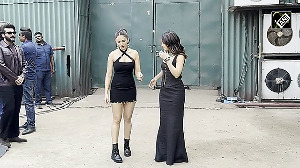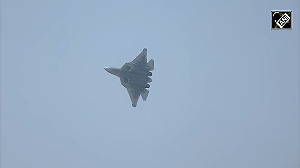On December 27, 2003, the first meeting between the Centre and investment bankers took place on the Oil & Natural Gas Corporation Ltd's equity offering.
The $2.2 billion issue (roughly Rs 10,000 crore) is expected to hit the market in February end or the beginning of March.
This is the most aggressive timeframe that investment bankers have ever faced while taking a public sector outfit to the market. They got five months to work on the Maruti Udyog initial public offering in June last year.
The Maruti issue, which was over-subscribed almost nine times, set the market on fire and helped change the psyche of scam-scared retail investors. Maruti's equity issue was an IPO.
But both ONGC and Gas Authority of India Ltd (Gail) -- which are preparing to hit the market in February-March -- are follow-on offerings. The government now holds 84.11 per cent in ONGC and 67.34 per cent in Gail.
The size of the Gail issue will be roughly over Rs 2,000 crore. But the primary market gravy train does end with the ONGC and Gail issues.
There are at least half a dozen companies that are gearing up to hit the market before the end of the fiscal year.
The list includes Dredging Corporation Ltd (follow-on offer, Rs 400 crore), IPCL (follow-on offer, Rs 1,500 crore), IBP (follow-on offer, Rs 800 crore), CMC Ltd (follow-on offer, Rs 200 crore), Petronet LNG (IPO, Rs 250 crore), Patni Computers (IPO, Rs 450 crore) and Biocon Ltd (IPO, Rs 300 crore).
If all these proposed public offerings actually materialise in the last quarter of the current financial year, over Rs 15,000 crore (Rs 150 billion) will be raised from the primary market in three months!
This is much higher than the primary market mop-up by equity issues recorded in any financial year in the history of the Indian capital markets.
The three best years for primary equity issues were between 1993-94 and 1995-96. In 1993-94, 713 primary issues raised Rs 6,188 crore.
The next year, the number of issues almost doubled to 1,304, but the amount of money raised jumped less than 50 per cent to Rs 8,949 crore. This essentially meant that the average size of the issues shrank as lesser-known entities made a beeline for the market.
This trend was more prominent the next year when the number of issues increased by exactly 100, to 1,404, but the amount of money raised actually dropped by over Rs 1,000 crore to Rs 7,754 crore (Rs 77.54 billion).
Greedy promoters killed the golden goose and the next few years witnessed a steady drop, both in the number of issues and corpus of funds raised, until 2000-01 when the infotech boom hit the market.
These days investment bankers are working overtime as the list of IPOs slated to hit the market after March is getting longer by the day.
Prime Database, a Delhi-based outfit that tracks both equity and debt markets, says five equity issues have already received approval from the capital market watchdog, the Securities and Exchange Board of India, 10 are awaiting approval while 131 are planning to approach Sebi with draft proposals.
Merchant bankers feel these numbers are realistic and can only swell if bullish sentiments continue.
Let's take a look at the catalogue: there are a few media and entertainment companies like New Delhi Television and Sony Entertainment Television.
Then, there are Shoppers' Stop, Barista Coffee, MTR Foods, Haldia Petrochemicals and Infrastructure Development & Finance Corporation.
In the banking sector, Bank of Maharashtra, Central Bank, Punjab & Sind Bank and United Bank of India are planning to reduce the government's holding by raising money from the public. That will leave only Indian Bank in the public sector as a wholly owned government bank. Finally, everybody is guessing that Reliance Infocomm and TCS will bite the bourses with mega issues but nobody knows the exact timing of their offerings.
Broadly, three types of equity issues are being lined up. First, the issues that form part of the government's divestment programme; ONGC and Gail belong to this category.
Second, venture capitalists like ICICI Venture, ILFC Venture and some foreign venture funds that had put money in certain ventures and are now planning to get out and encash their holdings.
The issues of Patni Computers, TV Today, Shoppers' Stop and Indraprastha Gas illustrate this trend, which is technically known as a "liquidity event". Most of these issues are partly offer-for-sale and partly expansion of capital base.
In the third category fall the companies in the pharmaceuticals, automobile, steel and commodity sectors that have been able to absorb the excess capacity created in the 1990s and are now looking for brownfield expansion.
If even half of the aspiring companies are successful in entering the market, the total fund mop-up in calendar year 2004 could be anywhere between Rs 25,000 crore (Rs 250 billion) and Rs 30,000 crore (Rs 300 billion).
Does the market have the liquidity to absorb this? Investment bankers say "yes", as the Indian market today is no longer a local market. It's a global market where foreign institutional investors are pouring in money.
This is the major difference between the over-heated primary equity market of the mid-1990s and now.
In calendar year 1995, the net equity buying by the FIIs was Rs 3,854 crore (Rs 38.54 billion).
The next year, it almost trebled to Rs 10,804 crore (Rs 108.04 billion) but again in 1997, the amount was almost halved to Rs 5,761 crore (Rs 57.61 billion); and in 1998, the FII net investment in equities was in the negative zone.
In contrast, in 2003, net FII investment in equities was Rs 30,792 crore (Rs 307.92 billion) and in the first 12 days of January it has been Rs 1,836 crore (Rs 18.36 billion).
Although no data is readily available on FIIs' primary market exposure, investment bankers say the foreign funds are indeed taking active part in primary issues. If this trend continues, liquidity will not be a problem in the primary market.
Besides, the retail sector is slowly coming back to the market. The TV Today IPO was an example of retail participation. The FIIs were not allowed to participate in the issue. The Rs 130 crore (Rs 1.30 billion) issue drew Rs 4,000 crore (Rs 40 billion) of retail subscription.
Normally risk-averse investors are taking a relook at the equity market as the highest return on bank deposits has fallen to 5.5 per cent and investment in the stock market through the mutual fund route is almost as liquid as bank deposits.
There are two main aspects that differentiate the equity issues of today from the mid-1990s: the quality of the outfits hitting the market and the pricing.
In the mid-1990s, dozens of horticulture, floriculture and plantation companies bought a piece of barren land, sowed seeds of some plants and rushed to the market to raise money from the public.
Similarly, some manufacturing companies entered the market after laying the foundation stones of their factories. Funds flowed from the market to promoters' pocket even before the building was constructed.
In 2000-01, some of the manufacturing companies converted their back-office (where a few computers were kept for accounting purposes) into new outfits --adding the word "infotech" either as a suffix or a prefix -- and rode high on the markets.
But the scene is very different now. Only established companies with a good track record are allowed to enter the market.
While Sebi is keeping a close tab on the quality of the equity issues, the investment bankers are cautious on the pricing front.
They want to sell the issues at "friendly" pricing. This is to ensure over-subscription and a premium at the secondary market.
These twin factors will help the great Indian bazaar to sustain the roller coaster till there is a drastic reversal in interest rates.






 © 2025
© 2025